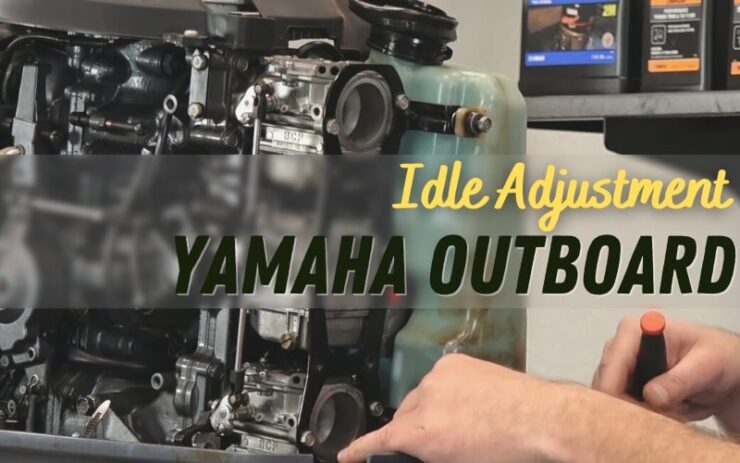Outboard idle refers to the idle speed of an outboard motor, which is a type of engine commonly used on boats. The idle speed is the speed at which the engine runs when it is not being used to power the boat.
Properly adjusting the outboard idle speed is important for the engine’s overall performance and longevity. The idle speed is typically adjusted by turning a screw on the carburetor or by adjusting the throttle cable.
A too-low idle speed can cause the engine to stall, while a too-high idle speed can cause excessive wear and tear on the engine, as well as decreased fuel efficiency. It is recommended to adjust the idle speed according to the manufacturer’s recommendations.
So, how does Yamaha outboard idle adjustment?
Well, there are five simple steps to follow for this. Firstly you need to stop the throttle valve. Next, you have to warm up the engine and attach the tachometer. Further, you have to obtain the idle speed and set the screw finally. These are the five simple steps for idle adjustment.
We are not done here. We have discussed all the steps in detail in the following article.
So if you have some spare time in hand, you can check on the detailed discussion right away.
Table of Contents
ToggleWhy is Outboard Idle Adjustment Important?
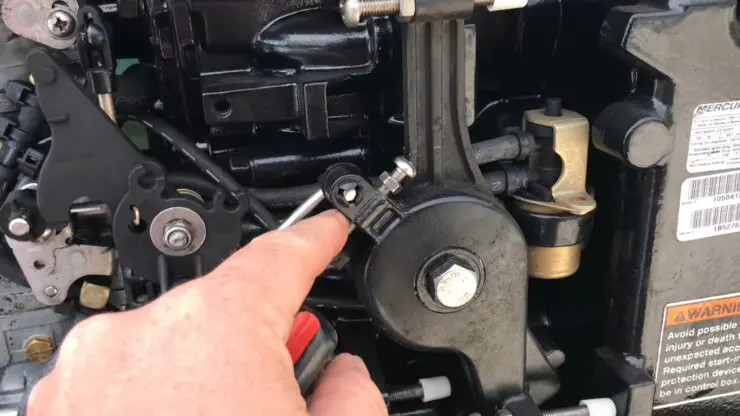
Outboard idle adjustment is an important aspect of boat engine maintenance. It is the process of adjusting the idle speed of an outboard motor to ensure it runs smoothly and efficiently. The idle speed is the speed at which the engine runs when it is not engaged in forward or reverse gear. The ideal idle speed for an outboard motor depends on the specific make and model of the engine.
There are several reasons why the outboard idle adjustment is important. First, an engine that idles too high or too low can cause serious problems. If the idle speed is too high, it can cause the engine to overheat, burn more fuel than necessary, and put excessive wear and tear on engine components. On the other hand, if the idle speed is too low, the engine may stall or have difficulty starting, and it may not run smoothly at lower speeds.
Second, adjusting the idle speed can help improve fuel economy. When an engine is idling too high, it is burning more fuel than necessary, which can result in decreased fuel efficiency. By adjusting the idle speed to the manufacturer’s recommended specifications, you can improve fuel economy and save money on gas over time.
Third, a properly adjusted idle speed can improve the overall performance of the engine. When an engine is running smoothly at idle speed, it is better able to respond to changes in throttle input and load. This can result in better acceleration, smoother shifting, and improved overall performance.
Finally, adjusting the idle speed is an important part of routine engine maintenance. Regularly checking and adjusting the idle speed can help prevent problems from developing and prolong the life of your engine.
Yamaha Outboard Idle Adjustment: in 5 steps
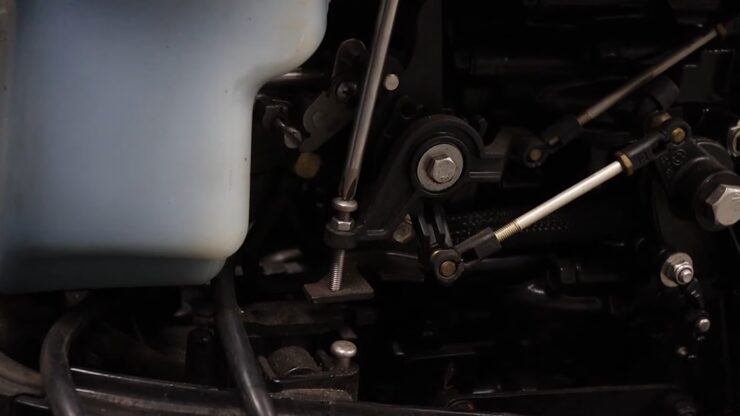
For a healthy and long-lasting outboard experience, it is very important to adjust the idle. It doesn’t require following a lot of complicated activities. All you need to do is to follow some simple steps.
Let’s discuss the steps thoroughly in the following.
Step 1: Stopping the Throttle Valve
At first, you have to stop the throttle valve fully. In order to do that, you have to loosen the throttle stop screw.
Now, lose the throttle lever securing screw as well. Loosen it at the upper and middle carburetors. For doing that, turn the screw clockwise.
Step 2: Warm-up
It is important to let the engine warm up first. So start the engine first and let it warm up for a while.
Step 3: Attaching Tachometer
Now, attach the tachometer. Attach it to the high-tension lead of the cylinder.
Step 4: Obtain Idle Speed
To obtain idle speed, adjust the throttle stop screw. Adjust the screw in and out until the time you get the specified speed. When turning in, the idle speed will get higher. While turning it off, the idle speed gets lower.
Step 5: Final Setting of the Screw
Finally, when pushing the throttle lever screw at the lower carburetor downward, tighten the throttle lever securing screw. The securing screw is located at the upper and the middle carburetor by turning the screw counterclockwise.
You can follow pretty much the same procedure for idle speed adjustment on the johnson outboard. Even for Yamaha 4-stroke outboard idle adjustment too.
Easy right? Just go through the steps again if you have any further confusion about it. And you are all set for the adjustment.
Common Outboard Idling Problem & Possible Solution
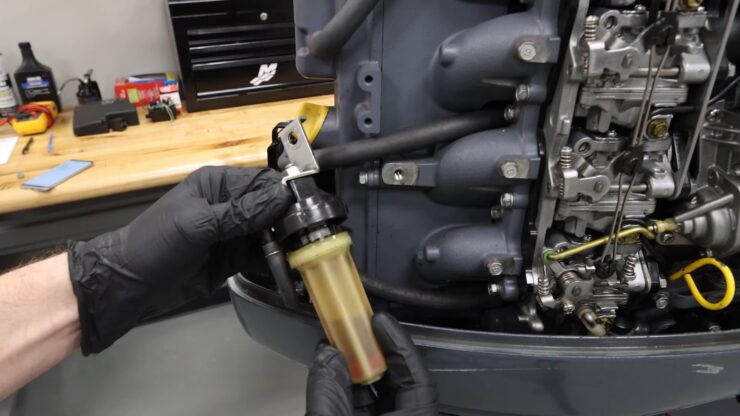
A very common issue with the outboard motor is that it stalls every now and then. Although it will keep the motor running and it won’t stop. But you still need to figure the problem out what is stopping your outboard from idling.
Here are a few things you need to check on while facing this issue.
Checking on Carburator
The carburetor problem is a very basic issue for outboard idling. If you face stalling on your outboard, make adjustments in the carburetor screws where needed.
Checking on Air Filters
If your outboard has fuel or air filters, you should check those thoroughly. Maybe the powerhead is having lacks fuel or air. Which is leading to stalls while idling. You can clean or replace the filters to get rid of the issues.
Checking on Spark Plug
For checking spark plugs, you need to remove them first. And check whether those are suitable for your outboard or not. Check if they are in good condition or not.
Or if the gaps between them are correct or not. That way you might be able to avoid the stall problem. Also, johnson outboard shift linkage adjustment can be an issue too.
Checking on Fuel System
Sometimes due to leaks in the fuel line, it refrains the flow of fuel. Also, the fuel vents should be open properly. A closed vent often creates a negative flow of fuel which ultimately leads to problem idling.
Checking on Fuel Injection
In some systems, there is fuel injection instead of a carburetor. In those cases, try to keep the idle air control clean. Those valves make sure generous airflow in the engine.
And if there is enough airflow in the engine, there will be no clogged dirt. Which will not cause any further idling issues for the outboard.
The issues are pretty much the same for Yamaha 4-stroke outboard idle problems too. Keeping these few things in mind, you can easily avoid any kind of unwanted issues while idling.
Vacuum Leak
A vacuum leak can cause an unstable idle by allowing unmetered air to enter the engine.
Check the hoses and gaskets for any leaks and replace them as necessary.
FAQs
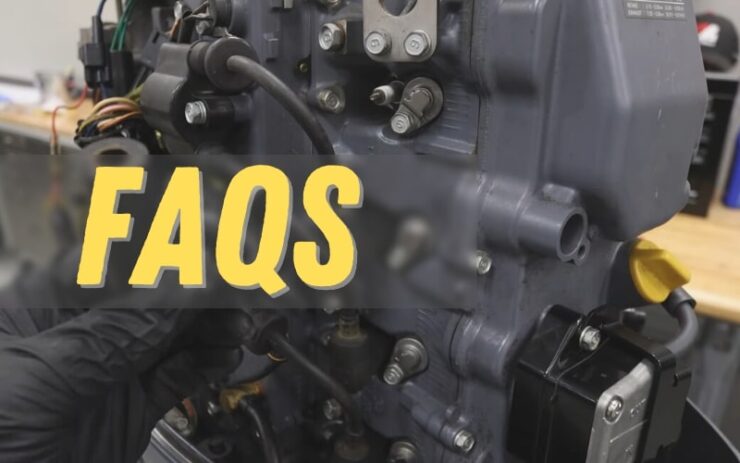
1. How you can set the correct idle?
Turn off the plastic cap first if it is still engaged. Next disconnect the sir adjustment valve of the idle. Also, disengage the electronic connector which holds the throttle body. Next, to adjust the idle, turn the idle screw. Turn it left to increase RPM and right to decrease it.
2. How can you adjust the idle on a two-stroke outboard?
At first, you have to adjust the idle stop screw situated near the choke cable. For that, you have to turn the screw with a help of a screwdriver. Do it until the vacuum gauge reading is around 600 RPM. Now move the idle screw mixture counterclockwise until you hear the engine start stalling out.
3. What are the reasons for the outboard motor to shake?
The most common reason for the outboard motor to shake is a broken or damaged propeller. To identify if the problem is with the propeller or not, you need to check on higher RPMs. If there is vibration intensifying while throttling at higher RPM, then the problem is in the propeller.
4. Why is my outboard motor shaking at idle?
The most common causes of an outboard motor shaking at idle are a faulty or damaged propeller, a misfiring engine, a clogged or stuck open fuel injector , a failed spark plug, a clogged or dirty carburetor, a clogged fuel filter, or a problem with the idle mix adjustment.
It is important to inspect the outboard motor and its components to determine the cause of the shaking. If the problem persists, it is recommended to have a qualified technician inspect the outboard motor for further diagnosis.
5. How do I fix my idle vibration?
To fix an idle vibration, you will need to inspect the outboard motor and its components to determine the cause of the shaking. Possible causes include a faulty or damaged propeller, a misfiring engine, a clogged or stuck open fuel injector, a failed spark plug, a clogged or dirty carburetor, a clogged fuel filter, or a problem with the idle mix adjustment.
Once the cause of the vibration is determined, it can be fixed by replacing the faulty part or components or adjusting the idle mix. If the problem persists, it is best to have a qualified technician inspect the outboard motor for further diagnosis.
6. How do you reset an idle control valve?
To reset an idle control valve, first, disconnect the battery to prevent an electrical shock. Next, locate the Idle Air Control (IAC) valve and remove it from the engine. Use a brush and some carburetor cleaner to clean the valve and the bore, then reinstall the valve. Finally, reconnect the battery and start the engine.
The engine should return to a normal idle speed. If the problem persists, it is best to have a qualified technician inspect the outboard motor for further diagnosis.
7. What causes RPM to drop at idle?
The most common cause of RPM dropping at idle is a faulty or damaged Idle Air Control (IAC) valve. The IAC valve is responsible for controlling the amount of air that is allowed to enter the engine when it is idling.
If the valve is not functioning properly, it can cause the engine to idle too low or even stall out. Other possible causes of RPM dropping at idle include a misfiring engine, a clogged or stuck open fuel injector, a failed spark plug, a clogged or dirty carburetor, a clogged fuel filter, or a problem with the idle mix adjustment.
Final Word
We hope by now you get all your queries solved regarding, Yamaha outboard idle adjustment. If you are doing it on your own, make sure to follow the steps accordingly.
One last tip for you, for a healthy outboard experience, you need proper maintenance of your outboard.
That was everything for today.
Until next time, safe boating!
I’m Liam Jackson, the proud owner and driving force behind KayakPaddling.net. Born somewhere in the expansive beauty of the United States, I’ve nurtured a lifelong passion for kayaking and fishing that has led me to explore the far corners of our nation’s waterways.
Related Posts:
- How to Adjust Carburetor on Johnson Outboard
- Johnson Outboard Rich Lean Adjustment - How is it Done
- Heavy Duty Fishing: 11 Best Rods And Reels For Big Fish 2024
- Johnson Outboard Throttle Cable Adjustment - Easy Steps!
- 11 Best Marine Carburetor for Your Boat 2024 -…
- Johnson Outboard Carburetor Problems - Best…

